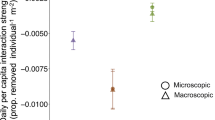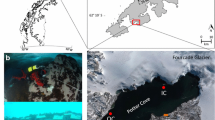Summary
Ecological factors regulating the species composition and abundance of the plant assemblage in the low intertidal zone were studied in the semiprotected San Juan Islands in Washington state. In particular, the roles of an abundant herbivore (the chiton Katharina tunicata) and competition among plants were evaluated experimentally. Densities of Katharina were manipulated in large areas to establish 3 treatments: Katharina removals (N=2), controls (N=2), and Katharina addition (N=1). These sites were monitored for 4 years. Over this time, algal abundance and diversity increased in the Katharina-removal areas; algae in most functional groups proliferated, and a multi-storied intertidal kelp bed eventually developed. In the Katharina-addition, the abundance of all plants except crusts, diatoms, and surfgrass decreased, and overall diversity declined. Control sites underwent year-to-year fluctuation in the abundance of the most conspicuous alga, Hedophyllum sessile, but remained otherwise unchanged.
At the end of the third year, the dominant space occupiers (the large brown algae) were removed from half of each of the Katharina removal and control areas. These kelps positively affect abundances of Katharina but are negatively correlated with limpet numbers. In the absence of competition from the kelps, the abundance and diversity of most other algal groups increased. This change was especially dramatic in the areas lacking both chitons and kelps, indicating that herbivory and competition have negative, additive effects on smaller algae. However, even in the absence of Katharina, abiotic disturbance (desiccation and storms) apparently mediates the competitive dominance of the kelps.
Similar content being viewed by others
References
Branch GM (1981) The biology of limpets: physical factors, energy flow, and ecological interactions. Oceanogr Mar Biol Ann Rev 19: 235–380
Dayton PK (1975) Experimental evaluation of ecological dominance in a rocky intertidal algal community. Ecol Monogr 45: 137–159
Dethier MN (1981) Heteromorphic algal life histories: the seasonal pattern and response to herbivory of the brown crust, Ralfsia californica. Oecologia (Berlin) 49: 333–339
Dethier MN (1984) Disturbance and recovery in intertidal pools: maintenance of mosaic patterns. Ecol Monogr 54: 99–118
Dethier MN, Duggins DO (1984) An “indirect commensalism” between marine herbivores and the importance of competitive hierarchics. Amer Natur 124: 205–219
Duggins DO (1980) Kelp beds and sea otters: an experimental approach. Ecology 61: 447–453
Gaines SD (1985) Herbivory and between-habitat diversity: the differential effectiveness of defenses in a marine plant. Ecology 66: 473–485
Grime JP (1977) Evidence for the existence of three primary strategies in plants and its relevance to ecological and evolutionary theory. Amer Natur 111: 1169–1194
Hawkins SJ (1979) Field studies on Manx rocky shore communities. PhD Thesis, University of Liverpool
Hawkins SJ, Hartnoll RG (1983) Grazing of intertidal benthic algae by marine invertebrates. Oceanogr Mar Biol Ann Rev 21: 195–282
Hay ME (1984) Patterns of fish and urchin grazing on Caribbean coral reefs: are previous results typical? Ecology 65: 446–454
Himmelman JH, Cardinal A, Bourget E (1983) Community development following removal of urchins, Strongylocentrotus droebachiensis, from the rocky subtidal zone of the St. Lawrence Estuary, Eastern Canada. Oecologia (Berlin) 59: 27–39
Hurlbert SH (1984) Psuedoreplication and the design of ecological field experiments. Ecol Monogr 54: 187–211
Jara HF, Moreno CA (1984) Herbivory and structure in a midlittoral rocky community: a case in southern Chile. Ecology 65: 28–38
Lewis JR, Bowman RS (1975) Local habitat-induced variations in the population dynamics of Patella vulgata L. J Exp Mar Biol Ecol 17: 165–203
Littler MM, Littler DS (1980) The evolution of thallus form and survival strategies in benthic marine macroalgae: field and laboratory tests of a functional form model. Amer Natur 116: 25–44
Lubchenco J (1980) Algal zonation in the New England rocky intertidal community: an experimental analysis. Ecology 61: 333–344
Lubchenco J (1982) Effects of grazers and algal competitors on fucoid colonization in tide pools. J Phycol 18: 544–550
Lubchenco J, Gaines SD (1981) A unified approach to marine plant-herbivore interactions. I. Populations and communities. Ann Rev Ecol Syst 12: 405–437
Lubchenco J, Menge BA, Garrity SD, Lubchenco PJ, Ashkenas LR, Gaines SD, Emlet R, Lucas J, Strauss S (1984) Structure, persistence, and role of consumers in a tropical rocky intertidal community (Taboguilla Island, Bay of Panama). J Exp Mar Biol Ecol 78: 23–73
Menge BA (1972) Competition for food between two intertidal starfish and its effect on body size and feeding. Ecology 53: 635–644
Nicotri ME (1974) Resource partitioning, grazing activities, and influence on the microflora by intertidal limpets. PhD Thesis, University of Washington
Nicotri ME (1977) Grazing effects of four marine intertidal herbivores on the microflora. Ecology 58: 1020–1032
Padilla DK (1984) The importance of form: differences in competitive ability, resistance to consumers, and environmental stress in an assemblage of coralline algae. J Exp Mar Biol Ecol 79: 105–128
Paine RT (1980) The third Tansley lecture. Food webs: linkage, interaction strength and community infrastructure. J Anim Ecol 49: 667–685
Paine RT (1984) Ecological determinism in the competition for space. The first MacArthur lecture. Ecology 65: 1339–1348
Paine RT, Vadas RL (1969) The effects of grazing by sea urchins, Strongylcentrotus spp., on benthic algal populations. Limnol Oceanogr 14:710–719
Sousa WP (1979) Experimental investigations of disturbance and ecological succession in a rocky intertidal algal community. Ecol Monogr 49:227–254
Sousa WP, Schroeter SC, Gaines SD (1981) Latidinal variation in intertidal community structure: the influence of grazing and vegetative propagation. Oecologia (Berlin) 48:297–307
Steneck RS (1982) A limpet-coralline alga association: adaptations and defenses between a selective herbivore and its prey. Ecology 63:507–522
Steneck RS, Watling L (1982) Feeding capabilities and limitation of herbivorous molluscs: a functional group approach. Mar Biol 68:299–319
Underwood AJ, Jernakoff P (1981) Effects of interactions between algae and grazing gastropods on the structure of a low-shore intertidal community. Oecologia (Berlin) 48:221–233
Author information
Authors and Affiliations
Rights and permissions
About this article
Cite this article
Duggins, D.O., Dethier, M.N. Experimental studies of herbivory and algal competition in a low intertidal habitat. Oecologia 67, 183–191 (1985). https://doi.org/10.1007/BF00384282
Received:
Issue Date:
DOI: https://doi.org/10.1007/BF00384282




